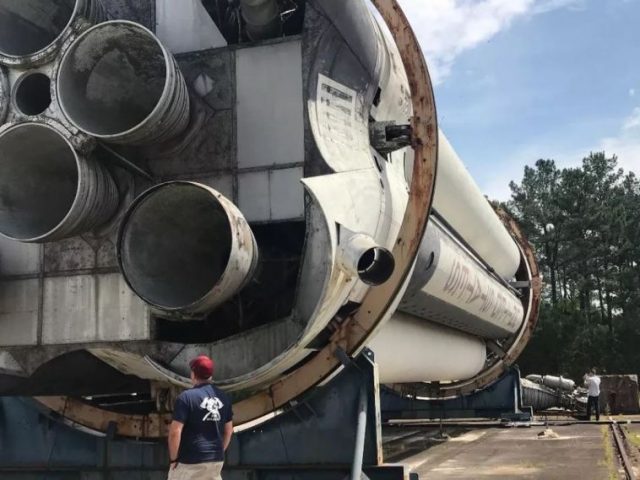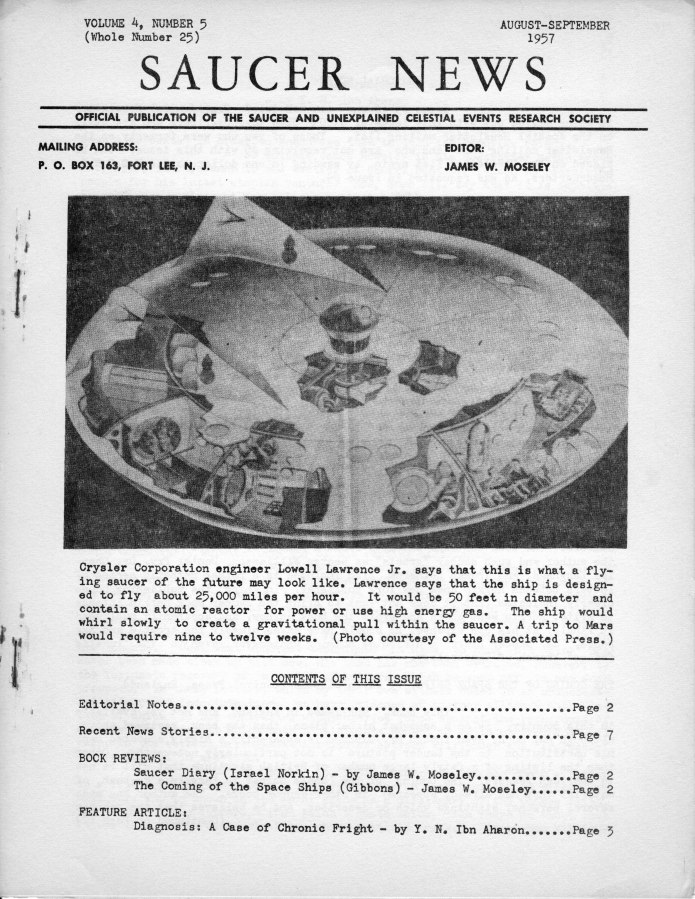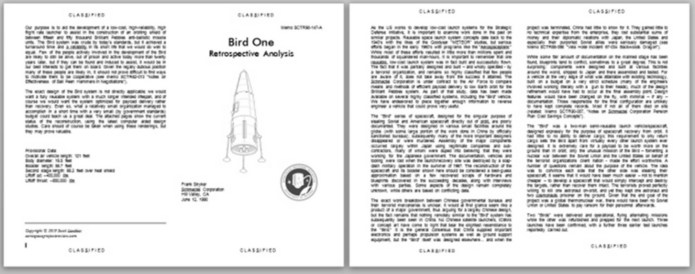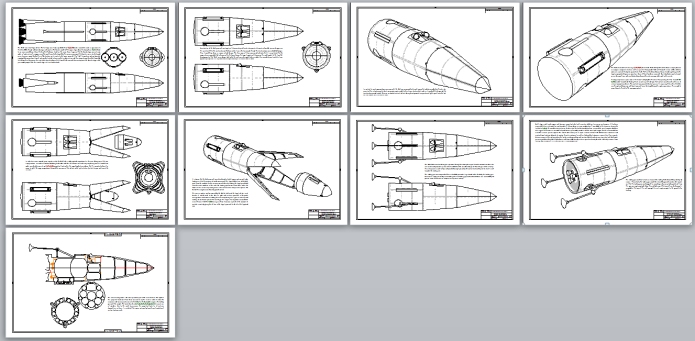Continuing…
Around three years ago I posted some rather cruddy images of a saucer-shaped nuclear-powered spacecraft that the Chrysler corporation drew up in 1956. At this time a manned spacecraft was a perfectly normal sort of thing for Chrysler to design; their aerospace division was responsible for the Redstone missile and the Saturn I first stage. One of the images was a small scan of the cover of the August-September 1957 issue of “Saucer News.” I finally managed to score a copy of this “fanzine”on ebay a while back and have scanned the cover at high (600 dpi) resolution. The image quality is a bit regrettable, but what can you expect from a 1950’s UFO magazine.
As always, if anyone might happen to know anything more about this design, I’m all ears. Chrysler long ago got rid of their aerospace division and whatever archive it might have had.
I have uploaded the full resolution scan to the 2019-08 APR Extras Dropbox folder, available to $4 and up subscribers to the APR Monthly Historical Documents Program.
One sizable document I’ve scanned for preservation is a Rockwell presentation package from October, 1985, showing a large number of space programs that the company could capitalize on. These included everything from minor mods to the Space Shuttle to major changes… stretching the orbiter, stretching the tank, adding additional boosters. Heavy lift boosters to put SLS to shame; heavy lift SSTOs; small experimental spaceplanes; manned military spaceplanes; space-based weaponry; space stations; space based nuclear power. Figured this stuff might be of some modest interest. So why not, I’ll post little bits of it from time to time.
NASA Giving Away Apollo-Era Saturn Rocket to Anyone who Wants It
It’s free to a good home. Just pay the modest $250,000 shipping fee.

I have an obvious choice: SpaceX. The Saturn S-1 stage was, as we all know, originally intended to be recovered after flight via parachutes with an ocean splashdown; this option was eliminated as a mass and cost savings measure, as were plans to add Rogallo wings or parafoils for a horizontal runway landing. I suggest that SpaceX get this stage, refurb it, fix it up and fly it, using one of the several proposed recovery methods.
Why? Because it would be cool, that’s why.
He may have almost single handedly handed South Vietnam to the commies, but at least ol’ Walt had a proper appreciation of the space program. Let’s listen to the launch of Apollo 4 as Cronkite discovers that the press building he’s sitting in is *way* too close to the launch site.
Obviously, rockets *do* work. And yet, there are people who believe they don’t. These people are sometimes flat Earthers, who cannot reconcile space travel with their world view and thus conclude that Its A Conspiracy. Sometimes they are people who fundamentally misunderstand basic physics and believe that rockets need something to push against, thus they can’t work in a vacuum. And then there’s this guy. At least Sir Sic’s mockery of him is entertaining.
As it turns out, I approve of this kind of “other ways of knowing.” I fully support the idea of the US federal Government expending considerable time, funds and efforts to promote this kind of thinking. It’s just that I want them to promote this kind of things *elsewhere.* Convince the Chinese and the Norks and the Iranians to accept this sort of thing and base their space programs around it.
This time, Chinese.
Congrats, of course. But SpaceX might want to take a look at their security procedures. Not saying the ChiComs couldn’t have done this on their own, but it’s hardly unlikely that they cheated.
Chinese launch firm Linkspace carried out a third hop test with its RLV-T5 tech demonstrator today, reaching ~300 metres in a 50-second flight, following with a successful powered descent and vertical landing. Source: https://t.co/4oz5PmyLyw pic.twitter.com/Odmztf0Ep0
— Andrew Jones (@AJ_FI) August 10, 2019
There seems to be something wrong with our bloody Russians this week.
A Russian military ammo depot that blew up earlier this week just exploded again
But wait! There’s more!
‘Brief radiation spike’ after rocket engine blast in northern Russia
Ummmm…
Radiation levels peaked between 11:50 and 12:30 (08:50-09:30 GMT) before falling and normalising by 14:00, the city administration in Severodvinsk said on its website, without reporting how significant the spike had been.
…
“They advise everyone to close their windows and drink iodine, 44 drops per glass of water.”
And…
Is Putin covering up a nuclear disaster? Ambulances covered in protective film transport six Russians who suffered severe radiation poisoning in mystery explosion during ‘test of new hypersonic missile’
UMMMMM…..
The Daily Mail article suggests that this was a “Zircon” hypersonic missile that exploded. The 3M22 Zircon is an experimental scramjet-powered anti-ship/land target missile with range of about a thousand miles, with the capability of carrying a 600 kiloton thermonuclear warhead. If there was a radiation release, that would indicate that the missile was carrying an actual nuclear warhead… something that seems *really* unwise for a peacetime test flight. it’s unlikely that the warhead actually detonated; that would be Big News virtually impossible to hide. Instead I guess the warhead must have either been blown apart by the chemical explosives, or trashed on impact. in either case, it seems a little odd that the radiation spike would go back down. You’d think there’d need to be a substantial cleanup. Unless, I suppose, the plutonium actually caught fire and burned and the smoke rifted downrange…
There is also speculation that this wasn’t a Zircon, but a Burevestnik nuclear-powered cruise missile. The existence of a truly nuclear powered Burevestnik is by no means certain, but who knows. In the unlikely case that this what what crashed, then perhaps the burst of radiation came from the engine melting down in flight or on impact; the drop in radiation coming as the reactor sank into mud or a pond or even just the dirt. Shrug.
Rocket Lab is, it seems, planning on recovering and reusing the first stage of their small Electron launch vehicle. The means of recovery is a lot lower tech than that of the Falcon 9… the Electron will pop a drogue ballute to stabilize, then open a parafoil to slow down and drift in the direction of a recovery ship. Before splashdown it will be air-snatched by a large helicopter then flown to the ship. Should be doable; the small size of the booster makes recovery of the entire first stage via this method practical, while Lockheeds Vulcan is, last I checked, only planning on recovering the engines and avionics.
This is of course no threat to SpaceX, which is going increasingly Bigger And Bigger. Still, it will be good to see yet more space launch systems working towards reusability and truly low cost.
On the other hand: no matter how capable Rocket lab gets with future boosters, their choice of launching from new Zealand will be a limiting factor. New Zealand has been since 1984 a “nuclear free zone,” excluding from its territorial waters any ship powered by nuclear reactors. While this would not necessarily seem to exclude nuclear powered spacecraft… why would someone with such a payload risk it?
I’m putting the finishing touches on this one. My hope, if I go into production with a number of these BoGPs, is to release at least two at a time: saves on shipping costs. But the “SPECTRE” BoGP will be a test case of sorts. If it is popular, more will come. If it tanks… well…
I’m still tinkering with the diagrams, but you can see below what I’m planing on including. Along with the diagrams will be a mess of explanatory text. Some will be on the diagrams themselves, as you can see; others will be on a separate cover page. For the science fiction designs, the intent is to describe the vehicle as if it was real, with an in-universe description. Sometimes from the people or organizations involved (which will be the case for SSV), and sometimes from the viewpoint of outsiders trying to describe them (such as is the case with the SPECTRE vehicle). Consequently, there will be more than just the dry statistics of length and weight, but also history and analysis from someone who may or may not understand the thing, and may or may not *like* the thing, and who may or may not be the sort of person you’d *want* to understand the thing.
For the SPECTRE, I have about three pages of text. To me it seems god, but I’ve been wrong about this sort of thing before. So I’m looking for three (3) people willing to give the cover pages (*just* the cover pages, not the mess-o-diagrams) a look, and then review in the comments section below what they think. Undoubtedly there’ll be spelling and grammatical errors, but what I’m interested in is… was it worth reading? Did it keep you interested? Make you more interested in the full booklet? Basically… was it good?
If you are interested, leave a comment expressing interest below, and if you’re one of the first three to do so I’ll send along a PDF of the cover page. This:
But not yet this:
Thanks.
Note: the in-universe text will be for different universes. The SPECTRE Bird vehicle isn’t from the same reality as the War Rocket Ajax or the Helicarrier or the Messiah. It might be interesting to try to create a Grand Unified Theory of Fiction slapping everything into the same continuity but… nah.




